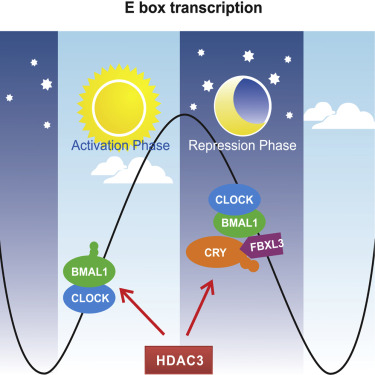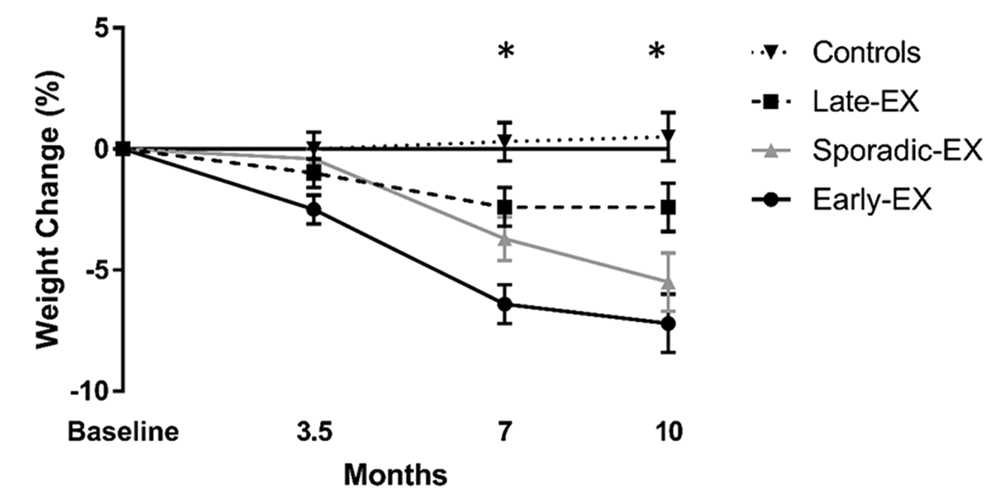Fat Loss
Fat loss is the breaking down of stored fatty acids into usable energy, thus leading to the shrinkage and depletion of adipocytes (fat cells). Lipolysis, or the breaking down of lipids (fats) is a highly regulated process that involves many hormones, signaling molecules, and facilitators. Some factors that promote the breakdown of fat into usable energy are hormones like epinephrine and glucagon and low levels of insulin, meaning the body is low on glucose and requires an energy source.
It is typically known that a caloric deficit is needed to reduce body fat. A caloric deficit means your body is spending more energy than it is consuming. This can trigger epinephrine and cortisol release, lower insulin levels, and subsequently cause the breakdown of fats into energy so that our body can remain functional.
The Circadian Clock and Metabolism
The circadian rhythm is a complex system influenced by external and internal mechanisms. To ensure every cell in our body is properly tuned, an internal biological clock regulates various physiological processes in a 24-hour cycle.
The circadian clock is regulated by a series of genes and proteins that interact in a complex feedback loop. The most prominent genes involved in the circadian clock are the Period (Per), Cryptochrome (Cry), Brain and Muscle ARNT-like 1 (BMAL1), and Circadian Locomotor Output Cycles Kaput (CLOCK).

BMAL1 and CLOCK form a heterodimer complex that activates the transcription of Per and Cry genes. Once synthesized, Per and Cry proteins form a complex that inhibits the activity of BMAL1 and CLOCK, creating a negative feedback loop that regulates the expression of circadian genes. This feedback loop generates a 24-hour cycle of gene expression that regulates the body’s physiological processes.
Recently, it was found that skeletal muscle metabolism is influenced in some parts by the time-of-day.

The day is often split into rest and active phase. Note here that mice are active during the night, in contrast to humans being active during the day. Nonetheless, exercise during each phase has different effects on skeletal muscle metabolism, whereas the effects of exercise timing on adipose tissue metabolism have not been studied extensively until now.
Exercise Timing and Adipocyte Metabolism
Our cells depend on the circadian clock, regulated by a transcription-translation feedback mechanism. This clock can be manipulated in part by external stressors like diet and exercise. To truly optimize the benefits of exercise, we can align our physical exercise with our circadian clock. Recent research has concluded that while exercise at different phases does not significantly affect circadian clock genes, exercise does impact metabolism in adipose tissue. Exercise taking place in the early active phase, but not during the rest phase, resulted in a significant increase in serum non-esterified fatty acids (NEFAs). The increase in NEFAs is a powerful indicator of lipolysis, suggesting that exercise during the early active phase significantly increases lipolysis (break down of fats).
The authors also analyzed subcutaneous adipose tissue and found that there was a time-dependent change in exercise response. Some of these changes included activated steroid hormone receptors, glucocorticoid receptors, DNA binding transcription factors, and the fibronectin binding pathway.
To further show that exercise-timing was the correct variable responsible for this increase in lipolysis, the authors controlled for catecholamine levels and feeding status. Both variables did not significantly alter the effect of early active phase exercise on lipolysis, leading the researches to conclude that early active phase exercise can lead to enhanced lipolysis.
Extrapolation
The data from this research suggest that early active phase exercise can enhance weight loss and possibly help combat obesity and type 2 diabetes. Although the research was performed on mice and the authors explicitly mentioned further investigation regarding the impact of exercise timing on diabetes is required, it may be beneficial to move some of your physical exercise to the early morning.
Human Data and Conclusions
A human trial conducted in 2019 concluded that despite minimal differences in components in energy homeostasis, participants in the early morning exercise group lost significantly more weight than the late exercise group. While there are lots of variables in this trial, this trend goes hand in hand with the preclinical data discussed earlier.

Although there is promising data suggesting weight loss can be enhanced by exercising in the morning, other studies have shown sex-dependent effects on exercise-timing. Other smaller studies have shown that other factors like sleep quality and blood pressure can be altered by exercising at different times. Altogether, be sure to match your goals with the timing of your workouts and be on the lookout for new trials with larger sample sizes investigating the importance of exercise-timing on our health and fitness goals.

Meet the Author
Hello everyone,
My name is Joshua Giblin. I am a post-bachelor researcher/research technician at USC. My interests range from nutrition to nanomedicine and also practical science to improve everyday life. Through this blog, I aim to communicate practical scientific research and present it to curious individuals so that an educated decision can be made. Thank you for reading the blog and showing your support.
References
- https://www.webmd.com/fitness-exercise/news/20220620/best-time-of-day-to-exercise-goals
- https://www.pnas.org/doi/pdf/10.1073/pnas.2218510120
- https://www.nature.com/articles/s41598-023-31082-0#Sec2
- https://www.nature.com/articles/s41366-019-0409-x